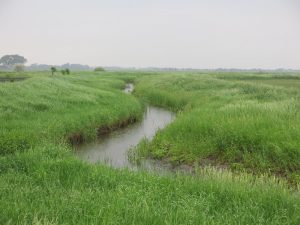I looked online today to identify what are the 10 most polluted waterways in the United States, and I came away from this search with a surprising insight. The pollution list (provided by Mother Jones) wasn’t for my purposes that valuable. It is almost entirely large waterways, like the Ohio and Mississippi Rivers, and some regional (though still large) rivers like the Rock River which flows between WI and IL.
Of much greater importance, in my mind, are proven methods (as noted in TakePart ) to reduce the farm runoff that ultimately flows into these rivers and – critically – smaller ones. Which then empty into inland lakes, large and small alike, as well as the global treasure that is the Great Lakes.
Often, a big part of a fix includes land buffers between crops and waterways.

Even golf courses which, according to this 2001 article by Jean McCay for Audubon International, may contribute modestly to excess nitrogen and phosphorus in waterways, can by having buffers effectively capture and retain much of what they do possess.
In addition to nutrient capture, the buffers often foster a rebirth in native vegetation, such as milkweed, which support at-risk species like Monarch Butterflies.
